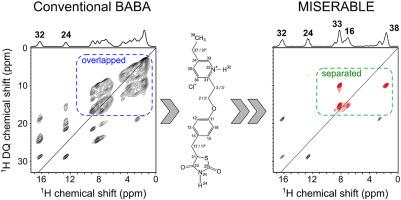Solid State Nuclear Magnetic Resonance ( IF 1.8 ) Pub Date : 2022-01-10 , DOI: 10.1016/j.ssnmr.2022.101774 Nghia Tuan Duong 1 , Vipin Agarwal 2 , Yusuke Nishiyama 3

|
Fast magic-angle spinning (≥60 kHz) technique has enabled the acquisition of high-resolution 1H NMR spectra of solid materials. However, the spectral interpretation is still difficult because the 1H peaks are overlapped due to the narrow chemical shift range and broad linewidths. An additional 13C or 14N or 1H dimension possibly addresses the issues of overlapped proton resonances, but it leads to the elongated experimental time. Herein, we introduce a single-channel 1H experiment to separate the overlapped 1H peak and identify its spatially proximal 1H–1H correlations. This sequence combines selective excitation, selective 1H–1H polarization transfer by selective recoupling of protons (SERP), and broadband 1H recoupling by back-to-back (BABA) recoupling sequences. The concept for 1H separation is based on (i) the selective excitation of a well-resolved 1H peak and (ii) the selective dipolar polarization transfer from this isolated 1H peak to one of the 1H peaks in the overlapped/poor resolution region by SERP and (iii) the detection of 1H–1H correlations from these two 1H peaks to other neighboring 1Hs by BABA. We demonstrated the applicability of this approach to identify overlapped peaks on two molecules, β-L-aspartyl-l-alanine and Pioglitazone.HCl. The sequence allows the clear observation of 1H–1H correlations from an overlapped 1H peak without an additional heteronuclear dimension and ensures efficient polarization transfers that leads to twelve fold reduction in experimental time compared to 14N edited experiments. The limitation and the conditions of applicability for this approach are discussed in detail.
中文翻译:

在快速 MAS 下使用单通道 1H 固态 NMR 分离重叠的 1H 峰并确定其 1H-1H 相关性
快速魔角旋转(≥60 kHz)技术能够获取固体材料的高分辨率1 H NMR 光谱。然而,光谱解释仍然很困难,因为1 H 峰由于窄化学位移范围和宽线宽而重叠。额外的13 C 或14 N 或1 H 维度可能解决重叠质子共振的问题,但会导致实验时间延长。在这里,我们介绍了一个单通道1 H 实验来分离重叠的1 H 峰并识别其空间上接近的1 H - 1H 相关性。该序列结合了选择性激发、通过质子选择性再耦合 (SERP) 进行的选择性1 H – 1 H 偏振转移和通过背靠背 (BABA) 再耦合序列进行的宽带1 H 再耦合。1 H 分离的概念基于 (i) 良好分辨的1 H 峰的选择性激发和 (ii) 从这个孤立的1 H 峰到重叠/差的1 H 峰之一的选择性偶极极化转移SERP 的分辨率区域和 (iii)从这两个1 H 峰到其他相邻1的1 H - 1 H 相关性的检测来自 BABA 的 Hs。我们证明了这种方法在识别两个分子 β-L-天冬氨酰-1-丙氨酸和吡格列酮.HCl 上的重叠峰的适用性。该序列允许从重叠的1 H 峰清楚地观察1 H - 1 H 相关性,而无需额外的异核尺寸,并确保有效的极化转移,与14 N 编辑实验相比,导致实验时间减少 12 倍。详细讨论了这种方法的局限性和适用条件。











































 京公网安备 11010802027423号
京公网安备 11010802027423号